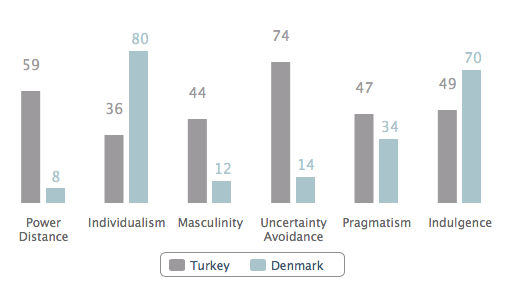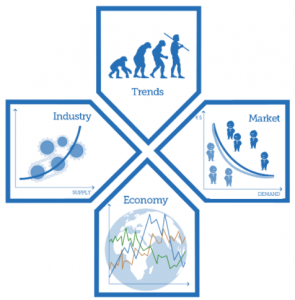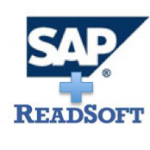Entering Foreign Markets in the Software Industry – Part 3
The software industry is by nature a global industry.
As the software industry is blessed with low cost of entry and simple value chains, international growth comes much easier in the software industry than in most other industries.
This series of posts discusses how to manage the business model when planning to enter foreign markets in the software industry.
The posts exclusively deal with B2B software business models requiring sales and support people in the field and thus some sort of local operation in the individual markets.
Links to previous posts in this series are located at the end of this post.
The Business Model Environment
Alexander Osterwalder, who gave us the business model framework, also introduced the business model environment.
While the business model represents those elements of our business that we can control, the business model environment represents all those elements that we cannot control.
The business model environment is divided into four areas (the four forces):
- Key Trends
- Market Forces
- Industry Forces
- Macro-economic Forces
As we move into a new foreign market we also move into a new business model environment. The business model environment framework offers an excellent approach to learn what the differences are and which tactical adjustments we should make to our business model and organization to become successful in this new environment.
Key Trends
The Key Trends cover such areas as:
- Societal and cultural circumstances and trends
- Regulatory circumstances and trends
- Technological circumstances and trends
- Socioeconomic circumstances and trends
Societal and cultural circumstances and trends certainly come in many forms and shapes. That language is one of the most “visual” differences is, however, only the tip of the iceberg.
The World Values Survey Association maintains a map of the world based on a few cultural parameters, which makes it completely different from the geographic world map.
The Hofstede Centre provides insight into differences in cultural issues such as the power distance, individualism, masculinity, uncertainty avoidance, pragmatism and endurance.

Hofstede: Denmark versus Turkey
While most software business model architectures will work in most countries the tactical implementation and execution must respect the cultural differences – or they will fail.
Legislation differs from country to country. Even the EU countries have substantial differences in legislation. If our software requires compliance with local legislation then we must add key partners to provide advice and organizational resources to manage the relationships and processes.
Other sources for information on society, culture, regulatory and technology circumstances and trends are available from The CIA FactBook, The World Economic Forum, OECD and local Statistical Departments.
Dealing with cultural differences from the outside is extremely risky. Nevertheless this is what most software companies do when making the first steps into a foreign market. I will recommend getting a “mahout” who can help you navigate and help make the right connections.
Market Forces
The market forces represents the demand side of our business: our customers.
It includes such areas as:
- Markets Segments
- Market Needs and Demands
- Market Issues
- Switching Cost
- Revenue Attractiveness
We obviously need to know how many potential customers there are in a foreign market and who they are, but also how they are organized, what specific requirements they have (which may be dictated by legislation and by our competition), where they meet, which media they use and who they take advice from.
Insight into the specific issues and challenges of the market in a foreign country can be critical for the tactical implementation of our business model.
As most B2B software represents an opportunity for process and workflow improvement, foreign markets with expensive cost structures are in general more attractive than countries with inexpensive cost structures. The Annual Competitiveness Index published by the World Economic Forum provides an excellent indicator of which markets may be most receptive to software based productivity improvement solutions.
Industry Forces
The industry force represents the supply side of our business: our competitors.
It includes such areas as:
- Competitors
- Other Value Chain Actors (independent channel partners)
- Substitute products and services
With low barriers of entry and industry growth in general, the competitive landscape in each country is very different.
The current incumbents, who enjoy the “home” advantage, mostly make entering new markets very difficult. Unless our value propositions offer some key differentiators and there is some awareness and demand in the market generated by “spill over” from other markets, then it may be very difficult and may take a long time to break the ice unless we allocate massive resources to the endeavour.
Most English-speaking software companies enjoy “spill over” externalities. They show up in Internet searches, when English-speaking people all over the globe are using search phrases corresponding to their activities. Software companies that participate in global industry exhibitions and conferences can also generate positive “spill over” effects, which can generate opportunities for new market entry.
Software companies operating locally and using local language only will obviously not enjoy positive “spill over” externalities.
The English speaking population on the globe is 1.5 billion compared to 400 million Spanish, 220 million French and 100 million German speaking. Chinese is also a major language, but the demand for B2B software from this group is negligible compared to the demand from the 1.5 billion English-speaking population.
Macro-economic Forces
Although macro-economic forces are very well documented they are probably also the less interesting for our market entry considerations.
Macro-economic forces change much faster than our perspectives for market penetration. We will typically apply a long-term perspective on a new market and in that time frame it is impossible to foresee the development in the macro-economic circumstances. Especially in the developing world, these circumstances may change rapidly.
The most important issue however, may be that the sales of our software can be anti-cyclical. Cost reduction and productivity improvement may be more critical in times of sluggish macro-economic times, while less critical when the economy is booming. Macro-economic forces normally affect big companies, while smaller companies may experience the exact opposite.
Booming markets, which are easy to identify due the statistics available, stimulate “gold-rushes”. This means that in boom times insurgents rush into the markets building up capacity expecting to enjoy surfing the growth wave. Entering strategic markets when they are at the bottom of a macro-economic cycle may actually make more sense.
Other Posts in this Series
Entering Foreign Markets in the Software Industry – Part 1
Entering Foreign Markets in the Software Industry – Part 2









